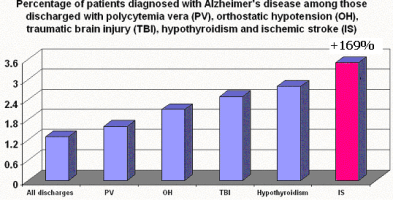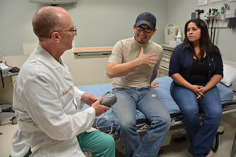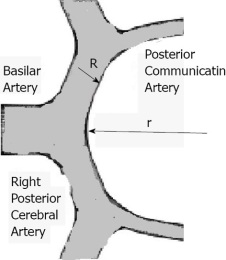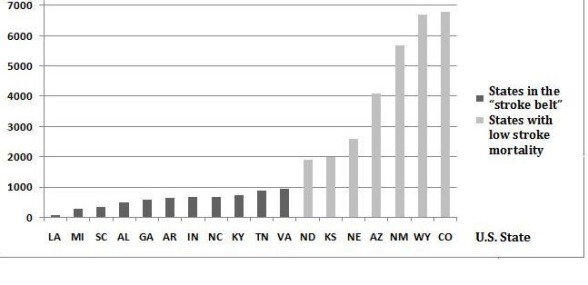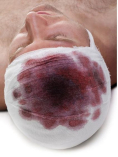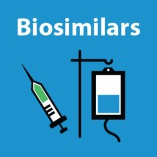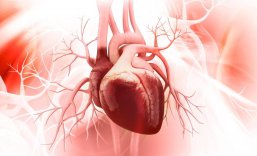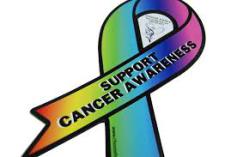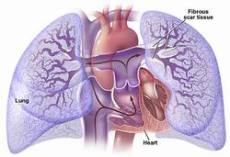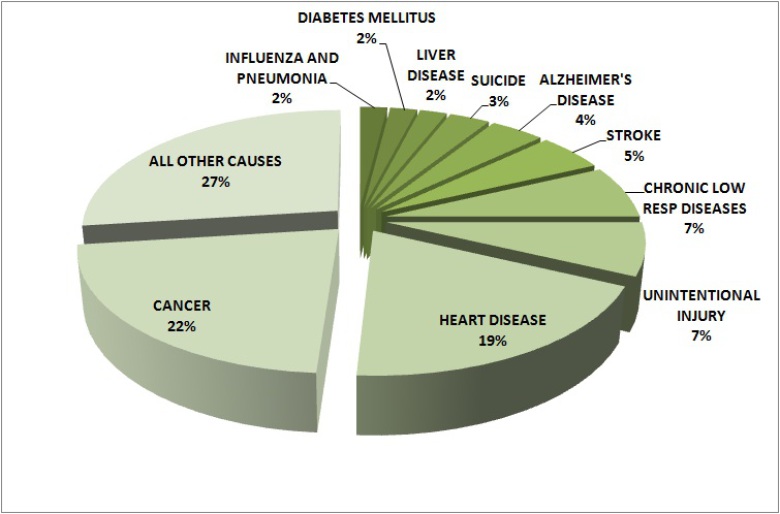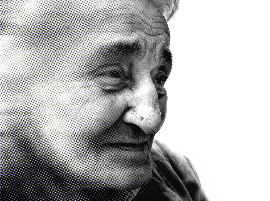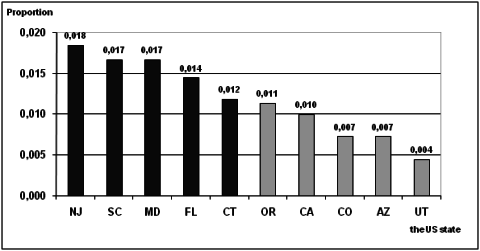
We improve people's lives through innovation in research and education
Alzheimer's disease and ischemic stroke:
big data suggest that they may share a common mechanism.
Ischemic stroke was thought to be much more prevalent than hemorrhagic stroke accounting for more than 90% of all strokes. However, recent research suggests than hemorrhagic stroke is more prevalent accounting for almost 41% of all stroke cases. Nevertheless, ischemic stroke remains a major public health concern with the total cost of care, treatment and lost productivity exceeding $40 billion per year.
Results from previous studies suggest that patients with stroke are likely to develop dementia. For instance, among patients hospitalized with acute ischemic stroke, the risk of dementia was 9.4 times higher than among the controls (p < 0.001). In addition, Alzheimer’s disease and stroke share common genetic factor namely the APOE ε 4 allele.
We analyzed several millions of hospital discharge data from 33 states provided by the National Inpatient Data Set (NIS) and found that the proportion of patients diagnosed with both ischemic stroke and Alzheimer’s disease was 2.7 times higher than the proportion of patients diagnosed with Alzheimer’s disease and any other co-morbidities (p < 0.001). The proportion of patients diagnosed with both ischemic stroke and Alzheimer’s disease was the highest among other co-morbidities that may share a common pathophysiological mechanism (i.e. increased blood viscosity as in the case of polycytemia vera or decreased blood cerebral velocity as in the case of hypothyroidism)
The toll from Alzheimer’s disease – the 7th-leading cause of death – continues to rise. There are now 6.5 million people in the U.S. (76,000 in Colorado) living with the incurable disease according to the Alzheimer’s Association 2022 Alzheimer’s Disease Facts and Figures Report, up 5% from previous estimates.
While it is unknown how COVID-19 will influence the number and proportion of people in the U.S. with Alzheimer’s, COVID-19 has clearly had a dramatic effect on mortality from Alzheimer’s and other dementias. According to the report, there were 44,729 more deaths from Alzheimer’s disease and other dementias in 2020 compared with averages during the previous five years — a 17% increase.
Please support our current research projects focused on Alzheimer's disease.
Together, we can fight Alzheimer's disease. Together, we are much stronger!
COVID-19
- Coronavirus (COVID-19) is an illness caused by a virus that can spread from person to person.
- The virus that causes COVID-19 is a new coronavirus that has spread throughout the world.
- COVID-19 symptoms can range from mild (or no symptoms) to severe illness.
- You can become infected by coming into close contact (about 6 feet or two arm lengths) with a person who has COVID-19.
- COVID-19 is primarily spread from person to person.
- You can become infected from respiratory droplets when an infected person coughs, sneezes, or talks.
- You may also be able to get it by touching a surface or object that has the virus on it, and then by touching your mouth, nose, or eyes
- Everyone is at risk of getting COVID-19.
- Older adults and people of any age who have serious underlying medical conditions may be at higher risk for more severe illness.
Shared decision-making: the future of medical practice
Shared decision-making (SDM) is when the patient and the provider share equal involvement and currently one of the most effective decision models. Many health care-related organizations such as the US Preventive Services Task Force the National Institutes of Health, the American Medical Association, the American College of Critical Care, and the American Academy of Pediatrics advocate SDM. In addition, SDM has become a prerequisite by Medicare and Medicaid for certain screening and medical procedures. preventive screenings and medical procedures
What are the benefits of SDM?
- Improved patient satisfaction and knowledge
- Better patient-provider communication
- Improved adherence to medication
- Better clinical outcomes
Example of SDM in clinical practice:
- Determine the situations in which SDM is critical
- Acknowledge the decision to the patient
- Describe options, including risks, benefits, and uncertainty associated with options
- Elicit patient preferences and values
- Agree on a plan for the next steps in the decision-making process
Our peer-reviewed research on sporadic Alzheimer's disease and atherosclerosis
Did you know that in the US only, more than 83,000 people die from Alzheimer's disease every year? Among elderly, roughly every 10th is diagnosed with this condition!
Moreover, there are nearly 5.5 Americans living with Alzheimer's disease. For comparison reasons, the population of Los Angeles is about 3.9 million people.
We proposed and publisjed the novel pathophysiological pathway where we introduced the Dean number (the degree of curvature) that can help to explain the specific involvement of the Circle of Willis in atherosclerosis and Alzheimer’s disease as anatomically different parts of the Circle of Willis would exhibit various degree of curvature which would predispose to Alzheimer’s disease.
Dr. Ismailov suggested that such mechanism can explain some sporadic cases of Alzheimer’s disease in the presence of minimal damage from atherosclerosis as well as open up new avenues for prevention of sporadic Alzheimer’s disease.
For more info, click here http://www.ncbi.nlm.nih.gov/pmc/articles/PMC3817283/
This research needs your support. Thank you for considering us!
Cancer awareness in Colorado
Cancer is the leading cause of death in Colorado, killing more than 7,000 people each year. One out of every seven women in Colorado will develop breast cancer during their lifetime. That compares with a national statistic of one out of every eight women. According to previous community-based needs assessment, the top barriers that have been recurring in those 22 counties in Colorado included the cost of breast cancer care, or in some instances, the perceived cost of care. Individuals don’t have transparent information about what it will cost to receive: a clinical breast exam, a mammogram, a diagnostic test, chemotherapy, surgery, or radiation.
We also know that barriers include having a lack of insurance. Contributing factors to the lack of insurance include the cost of premiums as well as not having the appropriate documentation status to qualify for various insurance programs that are offered. We have also been able to find out that barriers include the location of the provider and the proximity an individual would have to travel to access care. That could include someone who works one or two counties away from their primary care facility or someone who does not have a primary care facility in their home county. When it comes to specialty care, we know that in Northeastern Colorado for example, someone who’s been diagnosed with breast cancer might need to travel upwards to 200 miles each way to access specialty services.
Another example is melanoma which is responsible for 75% of all skin cancer deaths and it is the 5th most commonly diagnosed cancer in Colorado. The annual rate of new melanoma diagnoses in Colorado was 15% higher than the national average and was the 13th highest in the U.S. An estimated 1,260 state residents were diagnosed with melanoma in 2009 only.
Traveling, headaches and change in altitude
Would you like to establish donor-advised fund for the above project? You may do so
https://www.fidelitycharitable.org/ or by donating to us. Please see more details at:
https://www.cmdat.org/home/our-projects/association-between-major-types-of-headaches-and-geographic-altitude-a-preliminary-report/
High altitude and aging research: thinking outside of the mountain box
Did you know that the oldest man from Bolivia (who is now 123) lives in the mountains at an altitude of more than 12,000 feet? Did you also know that some US large cities are located at high altitude such as Denver (5,278 feet), Cheyenne (6,062 feet) or Santa Fe (7,000 feet) etc. Previous large population-based studies found that residents of areas situated at 1500 m or above have longer life expectancies as compared to those who reside at sea level.
On one hand, high altitude may have a detrimental effect on various anatomical structures such as muscle structure due to lowered muscle fiber density, mitochondrial volume and enzyme activity involved in aerobic oxidative metabolism. On the other hand, hypoxia can also trigger some potentially beneficial physiological reactions to protect human organism from damage. One potentially beneficial reaction is the higher production of erythropoietin (EPO) by human kidneys. Previous research evidence suggests that subtle hypoxia (5,340 feet) can result in increased production of EPO while presence at 3,000 m above the sea level may result in a sharp, almost 2-fold renal EPO production.
Our previous research indicates that the rate of hospitalizations for some conditions is also lower at higher altitude levels. For instance, the proportion of heart failure discharges to all discharges in Maryland (low average altitude) is nearly 2-fold bigger than such proportion in Utah (high average altitude) (0.123 versus 0.064, respectively). In addition, we examined hospitalizations rates for Alzheimer’s disease (AD) and we found that rates of AD are significantly lower in the “mountain” states of the US as compared to the states in the lowland area. For example, the proportion of AD discharges to all discharges in low altitude South Carolina or in lowland Maryland is more than 4-fold bigger than such proportion in high altitude Utah (0.017 versus 0.004 respectively).
Evidence that high altitude may have lower rates of certain disorders may help to identify a new line of treatment such as various EPO regimens, hyperbaric chamber as well as justify new research in the area. On the other hand, evidence that high altitude may increase risk for various study outcomes may open up new “population at risk” (i.e. high altitude residents, elderly etc.) as well as new avenues for prevention and treatment. For instance, it is possible that individuals with chronic migraine are more likely to have an onset of new clinical symptoms when traveling to high altitude area, therefore such patients and their families would be advised to contact physicians prior to travel.
Alzheimer's disease from a new angle
Interestingly, it has been more than a century since the discovery of Alzheimer’s disease and yet, the cause of Alzheimer’s disease as well as its exact mechanism remains unknown. Once we understand the mechanism of the development as well as the cause of Alzheimer’s disease, we will be able to find an effective treatment.
Alzheimer’s disease is a neurodegenerative disease with a strong vascular component and the most frequent form of dementia. Common symptoms include confusion, irritability and aggressive behavior. Alzheimer’s disease affects language and memory skills as well as other vital functions. The prognosis varies from one person to another but is generally poor with the average lifespan of the Alzheimer’s patient of about seven years. Only about one in fifty individuals diagnosed with Alzheimer’s disease will survive longer than 14 years following the diagnosis.
De la Torre and colleagues have proposed that lowered cerebral perfusion in combination with an energy-dependent intracellular metabolic breakdown can cause sporadic Alzheimer’s disease. A cascade of biochemical reactions can be initiated by decreased cerebral blood flow eventually leading to neurodegeneration. Results from several studies have supported the idea that cerebral hypoperfusion may be associated with Alzheimer’s disease. Additionally, population-based research supports the idea that Alzheimer’s disease may be associated with disorders that either have a strong vascular origin or may cause vascular hypoperfusion. Thus, cumulated research evidence has suggested that Alzheimer’s disease is linked to vascular pathology.
However, the mechanism explaining how lowered cerebral blood flow can result in suboptimal delivery of metabolic substances to the brain tissue is not well understood. As mentioned earlier, the beta amyloid peptide deposition and its further accumulation can result in degeneration of smooth muscle cells in the endothelial wall to the extent of the appearance of defects in the wall itself. Other vascular changes include hyalinization and aneurismal dilatation of the vascular wall. Animal-based studies showed that long-term hypoperfusion can lead to vascular lumen distortion as well as basement membrane thickening. One of the theories is that a degenerated vascular wall can result in the normal laminar blood flow becoming turbulent. Amyloid deposits (as well as other changes described above) can disturb the structure of vascular wall by changing its geometry. In turn, there will be conditions for the appearance of turbulent flow, which can decrease the normal delivery of oxygen and other important chemicals to the brain tissue. In addition, wasted metabolic products can not be properly removed from local brain tissues.
Please see our current projects for more information
Stroke and geographic altitude: more research is needed!
Did you know that roughly 140,000 people die each year from stroke in the United States? Nearly 800,000 Americans suffer a stroke each year! For comparison reasons, the population of Seattle, WA is nearly 750,000 and San Francisco, CA is around 852,000.
Stroke mortality rates vary substantially not only internationally but often within each country. One of the classic examples is the variation in stroke mortality in the U.S. For decades, higher stroke mortality rates are reported in the Southeast of the U.S. particularly along the coastline. Such specific stroke rate pattern relates to several states including Alabama, Arkansas, Georgia, Indiana, Kentucky, Louisiana, Mississippi, North Carolina, South Carolina, Tennessee and Virginia. The phenomenon has been called the “stroke belt”. In the same time, lower rates have been observed in the Northeastern of the U.S. and particularly lower rates have been reported in the Mountain region.
Our analysis shows states with highest and lowest stroke mortality rates with regard to the mean elevation in those states. Those states that are traditionally included in the “stroke belt” in
the order of increasing mean altitude (Louisiana, Mississippi, South Carolina, Alabama, Georgia, Arkansas, Indiana, North Carolina, Kentucky, Tennessee and Virginia) are painted using darker color.
Several states (North Dakota, Kansas, Nebraska, Arizona, New Mexico and Wyoming Colorado) with low stroke mortality rates are painted using lighter color. Therefore, as it can be seen from the
Figure, most population from the states with low stroke mortality live at much higher altitudes as compared to those living in the “stroke belt”.
We hypothesized that the nonrandom stroke distribution is related to regional differences in individual levels of EPO, which production depends on the tissue hypoxia due to variation in altitude.If
successful, future studies based on this hypothesis may open up new avenues for treatment of such an important health issue as stroke.
Read more here: https://www.ncbi.nlm.nih.gov/pubmed/22626952
Traumatic brain injury and altitude: where do we stand?
Did you know that 1.7 million Americans sustain a TBI annually? This is more than population of Philadelphia!
Our recent high altitude research project proposes that high altitude can potentially trigger many negative post-head trauma outcomes such as post-traumatic headache, depression, or post-traumatic stress disorder.
Read more here:
http://www.ncbi.nlm.nih.gov/pubmed/27045498
Glaucoma awareness month in Denver, CO
Thank you to everyone who attended our glaucoma awareness seminars!
Glaucoma is the second leading cause of blindness in the world, according to the World Health Organization. In the U.S., more than 120,000 are blind from glaucoma, accounting for 9% to 12% of all cases of blindness. Very importantly, it is estimated that over 3 million Americans have glaucoma but only half of those know they have it. After cataracts, glaucoma is the leading cause of blindness among African Americans.
Biosimilars: what are they?
What is biosimilarity? Let’s take a look at the definition first.
‘‘The biological product is highly similar to the reference product notwithstanding minor differences in clinically inactive components, and there are no clinically meaningful differences between the biological product and the reference product in terms of the safety, purity, and potency of the product” (FDA on Biosimilars)
Suppose that you need to make a copy of a paper with text. You may simply use a copy machine and you will get the exact same copy of your text. Similarly, you can get an exact copy of a small-molecule brand name drug, also called a “generic”.
Copying biologic products more closely resembles ordering another one of the most recent generation computers with highly similar specifications. The new computer may vary slightly from your current model but will hold to the same performance standards. For example, the replacement computer will likely have slightly different design or other insignificant differences. Nevertheless, the replacement computer is fully capable to perform nearly exactly as the original.
The scenario with the replacement computer is similar to biologic products. That’s because unlike small-molecule drugs, biologic products are manufactured from living organisms and cannot be exactly copied. However, a highly similar copy (“biosimilar”) of the referenced biologic product (like the replacement computer that you ordered), could be developed. This copy will be highly similar to the referenced biologic product in many important aspects such as efficacy, safety and purity but will not be identical. Therefore, biosimilars can be viewed as therapeutic alternatives to a referenced product. However, because of the difference in the manufacturing process, they are not identical to the referenced biologic products. Therefore, biosimilars cannot be classified as generic drugs
Heart failure awareness month in Denver, CO
Thank you to everyone who attended our heart failure seminars.
Did you know that approximately 1 person dies from cardiovascular disease every hour in Colorado? Among adult Coloradans in 2013, only 6% were aware of having cardiovascular disease and only 26% were aware of having high blood pressure.
Our team designed those seminars to serve as a resource for patients or caregivers who want an in depth understanding of various heart failure issues such as risk factors, clinical symptoms, prevention and treatment.
Cancer awareness month in Denver, CO
Cancer is the leading cause of death in Colorado, killing more than 7,000 people each year. In 2013, 21,935 Coloradans were diagnosed with cancer and nearly 200,000 Coloradans are alive with active cancer or a history of cancer. One out of every seven women in Colorado will develop breast cancer during their lifetime. That compares with a national statistic of one out of every eight women.
Our highly effective outreach cancer awareness program has helped hundreds of low income families in the Greater Denver Area. We have been partnering with many local organizations as well as oncology/hematology offices and we have provided many important educational modules focused on various types of cancer such as renal cell carcinoma, skin cancer and melanoma, ovarian cancer, pancreatic cancer, lung cancer, breast cancer, leukemia and gastrointestinal stromal tumors.
Free information brochures focused on pulmonary arterial hypertension and Gaucher disease for Russian-speaking patients in Denver, CO
The Russian-speaking community is one of the fastest growing communities in the Greater Denver Area which consists of approximately 70,000 people. We created 1,000 tri fold brochures in Russian
language for each topic of interest (pulmonary arterial hypertension and Gaucher disease), 2,000 brochures in total and we provided each one of 10 original sites with 100 brochures on each topic.
We are offering free community-based seminars to locals. To reach as many low income families, women, refugees and minorities as possible, we are partnering with many local organizations and communities such as Celebration Community Church, Virginia Village Library, African Community Center, Colorado Heights University, Rocky Mountain Communities, YMCA, Inner City Clinic etc.
Did you know? Leading causes of death in Colorado (2010 data)
CMDAT in the news: altitude and ocular diseases and injuries: are they related? Evidence that prevalence of important vision and ocular disorders, ocular injuries and their outcomes may vary at various altitude areas may open up new avenues for treatment, including emergency ocular trauma and optic nerve injury care. Such studies may help to identify various factors (i.e. age, gender, etc.) related to prevention, treatment and rehabilitation of patients diagnosed with a number of vision and ocular disorders at various altitudes. For more info, please visit http://www.ncbi.nlm.nih.gov/pmc/articles/PMC4346680/
Geographic altitude and multiple sclerosis: is there a connection? find out more:
https://www.facebook.com/notes/ccsvi-in-multiple-sclerosis/altitude/437286037210
Did you know? The production of neurotransmitter synthesis in the brain can be disrupted by thehypobaric hypoxia resulting from high elevation and this may contribute to methamphetamine us. Read more here http://www.ncbi.nlm.nih.gov/pmc/articles/PMC4225207/
Alzheimer's disease and altitude: are they connected? The following graphs from our publication indicate that Colorado has relatively low rate of hospital admissions with Alzheimer’s disease .
For example, the proportion of hospital admissions with Alzheimer’s disease to all hospital admissions in our state is nearly 2.5-fold smaller than such proportion in the “lowland” states such as South Carolina or Maryland (0.007 versus 0.017 respectively), yet we are not as good as Utah (0.007 versus 0.004 respectively) and Utah, by the way, has higher average altitude compared to us (check that on web).
For more info, please visit:
Did you know that high altitude may increase risk of prematrity? In the 1950s, Colorado had the highest rate of premature births in the US. Read more http://www.ncbi.nlm.nih.gov/pmc/articles/PMC3146554/

